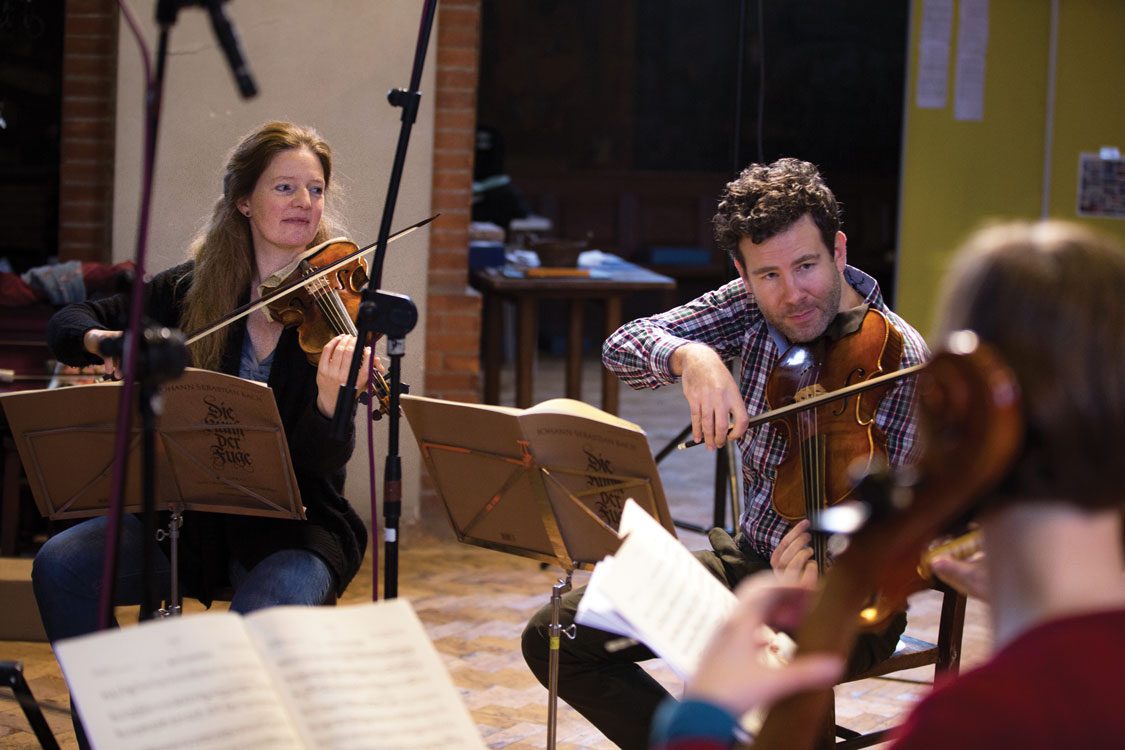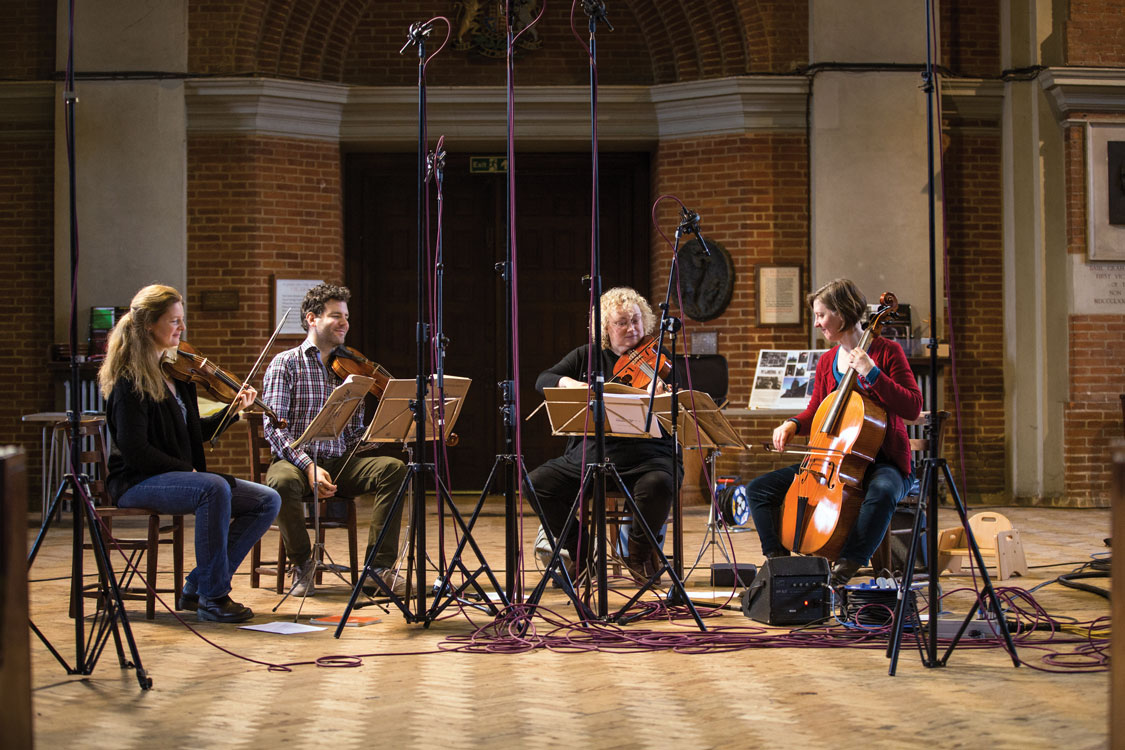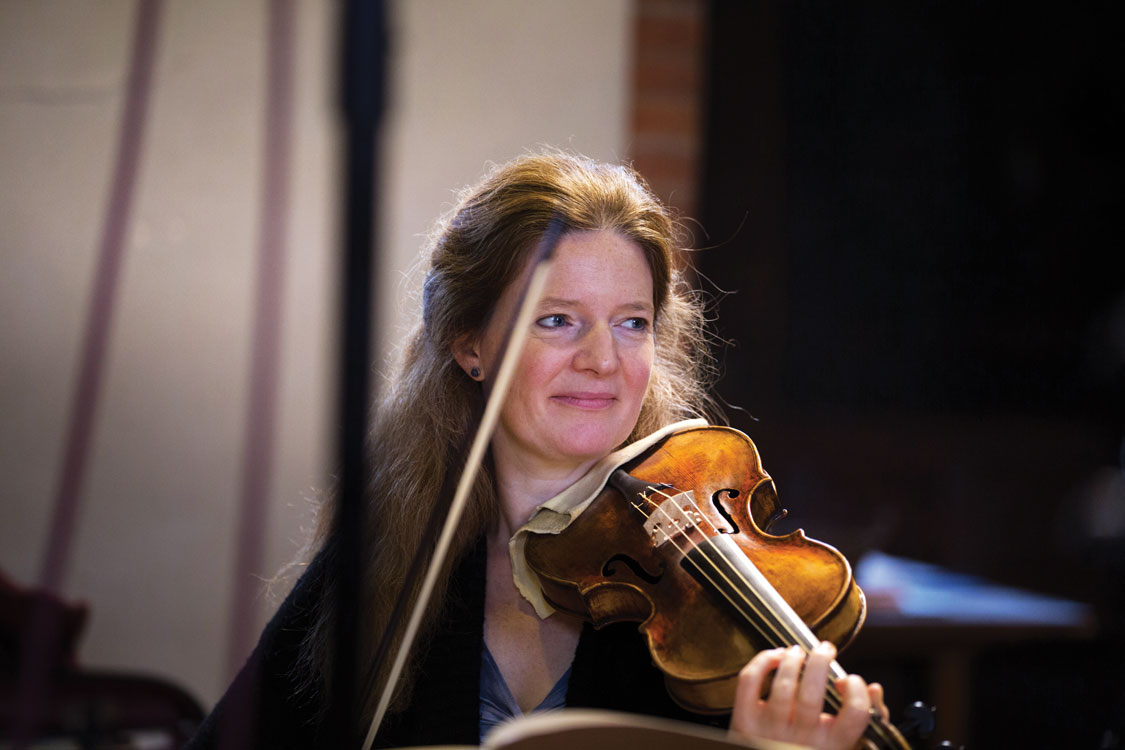Recording Bach's The Art of Fugue, with Rachel Podger
Peter Quantrill
Tuesday, April 18, 2017
Bach’s Art of Fugue may be an intellectual work but, as violinist Rachel Podger tells Peter Quantrill, it has wit and humanity too

The smile that greets me in a practice room of the Royal Academy of Music in London is wide and beaming. And familiar from a clutch of award-winning recordings, the latest of them being Biber’s Rosary Sonatas, which has just won Gramophone’s Baroque Instrumental disc of the year.
Smiles were probably harder to come by during the recording itself, but ‘positive mental attitude’ is evidently a tenet of Rachel Podger’s life as a violinist, director and teacher. ‘We had such huge challenges because of the scordatura techniques,’ she recalls. ‘It was January, it was cold, I had a cold, there was lots of wind, things were clattering about. We kept a positive focus, because that’s what you need to get anywhere with anything. But there were quite a few hindrances, and the tail of my violin was fraying because of repeatedly changing the tension of the instrument by retuning the strings. I was so tired after all that.’
Biber’s two-hour sonata sequence embodies physical struggle as it works with painfully chromatic steps through the life and Passion of Christ. Podger’s latest project, however, has entailed less suffering, and rather more corporate joy taken from making music with her Brecon Baroque colleagues. The academic reputation of The Art of Fugue can take a hike: Podger has evidently had serious fun with Bach’s unfinished testament. ‘Normally you come out of a set of sessions and you’re utterly drained. But we had the luxury of playing The Art of Fugue over three days, and it was a beautiful experience. We didn’t want it to end, it was so immersive and so enriching.’
The notorious title may or may not have been Bach’s own, but it does set up expectations of an intellectual challenge which, I suggest, has sometimes hindered its reception. Her answer is characteristically pragmatic: ‘It is intellectual and serious. But that doesn’t mean there isn’t plenty of humanity and wit. Maybe people have slightly disengaged attitudes to the word “art” because it seems aloof and not part of life, but I don’t think that’s meant here. This is the craft of the fugue. The Art of Fugue isn’t dry at all. It’s full of everything.’

Left to us are a 1742 manuscript version with 12 fugues (contrapuncti, Bach called them) and two canons, and a fuller first edition of 14 fugues and four canons, supervised by CPE Bach and printed posthumously in 1751. Despite the presentation of the score on four open staves (one per voice), keyboard players have good grounds to claim the piece for themselves. Viol consorts, saxophone quartets and symphonic orchestras have been no less justifiably unwilling to let the harpsichordists clasp it to their bosoms. ‘There are lots of different ways of doing it,’ reasons Podger, ‘and they’re all valid. I think it’s wonderful to do a late-night, candlelit festival performance with harpsichord. It puts you to bed and you wake up the next morning so refreshed because your brain has been ordered by all the fugues.’
For ensembles, more preparation is needed. There are questions of ordering, voicing and ending. Podger and her colleagues worked out their answers by, in essence, workshopping the piece through rehearsals and concerts. ‘When we performed it, we broke it up and spoke between fugues, developing our ideas of how to present it as we went along. In the first concerts there was more talking. We took it in turns to explain each one with a couple of sentences: “This is hard, this is funny, this is serious.” But it seemed too much like a lecture. Bach is already incredibly expressive.’
Through the course of the work, in roughly standard ordering, the fugues become ever more knotty and intricate, leading you through the workings of the creative mind. Both on the page and on whichever instrument is employed, Bach’s pride in technical and intellectual virtuosity is evident. ‘You can tell he is enjoying the challenge of continually developing, because that’s how his whole career went. He was always learning from the very start. He must have been a nightmare teacher – very demanding. A bit like Jeremy Paxman on University Challenge: “Come on, come on!”’
We look at the theme itself. A D minor tonic chord arpeggio, a scale fragment, a concluding twiddle. Child’s play, yet pregnant with possibility when laid over the four strings of the violin. ‘For string players it’s satisfying. You have these two open strings: completely natural. Then the third, which adds the tonality of D minor. Then this over-the-string C sharp, which gives it a bit of weight because physically you have to go there, and it’s a thicker string you’re going to, which gives it an immediate shape and weight, and makes a springboard to the resolution. The inversion isn’t so satisfying in that way. You have to decide whether you’re going to do a proper mirror image or make it different, because the chromatic B flat lies on the same string, so there isn’t the same physical reaction as there is to the C sharp, and it’s higher – it comes out more gently. So we tried different things together.’

These are the nuts and bolts of a workshop treatment, in which performance and interpretation evolve together, entwined like strands of DNA. One grounding principle to which Podger returns several times is tactus. This concept describes the rhythmic scaffolding for counterpoint – whether in Palestrina masses, Gombert motets or Bach sonatas – and leads musicians into understanding how to move with each other like cyclists in a peloton. ‘This aspect of consort was the most enjoyable thing for me,’ she remarks. ‘As a solo violinist you don’t often have the opportunity to play in consort, unless you do it at college, or for fun. To play The Art of Fugue – or Lawes, or Locke, or Purcell – you need to understand tactus, polyphony and all those earlier styles, in order to latch on to what’s important in terms of being together but not trying too hard to be together. Everyone is equal here. But I also find that’s the case in the concertos. The D minor Concerto for Two Violins says concerto a sei on the front page. It’s so revealing. Sometimes I’ll be teaching violinists who come along to do their solo thing in that piece, and I’ll have to say, “Hang on! You’re just part of a web!”’
The experience of collegiality is refined and purified by the requirements of counterpoint. Podger explains: ‘It’s important to take this music away from the instrument and listen to it on the keyboard, or sing it, or read it. You don’t need “I am a violinist”, you need “I am playing this theme right now”, so that you become the music. And I think that’s why this recording was incredibly enriching and uplifting, and a lovely escape from the real world.’
Even after years of accumulated trust and performances, Podger and her colleagues still need a bit of to-and-fro banter. ‘Occasionally, in a tricky bit you’d have to say in rehearsal, “Oi, I’ve got the theme!” – but most of the time Bach has written it out for you.’ She draws a distinction between the soloist-led brilliance of the Italian tradition exemplified by Vivaldi, and the kind of ego-free personality required to collaborate on The Art of Fugue. ‘Tactus is always good for getting rid of ego! But that doesn’t mean you play without expression or personality. Leaving the ego behind is difficult for some students who are used to thinking about every single musical decision. But being a musical channel means letting the ideas come to you, rather than you interpreting them. Then you need to own them, otherwise they won’t come out at all and you’ll sound like a robot.’
Podger does a lot of this didactic work, both in one-to-one coaching at institutions such as the RAM and the Juilliard School, and as the director of larger groups and annual summer courses, including this year’s Oregon Bach Festival. The evening before we met, she had led the European Union Baroque Orchestra at St John’s, Smith Square in London, and the fruits of her labour were joyfully evident in the disciplined freedom of her charges. On a whistlestop tour of Baroque Europe – Lully, Handel, Hellendaal, Vivaldi – Podger’s fellow first violins cleaved to the contours of her posture and rhetoric, whereas the second violins opposite her paid attention to her gestural lead but in a state of more unpredictably relaxed animation. Compared with her path-breaking days of study at the Guildhall School of Music, there’s now ‘more acceptance of what works for you’ in terms of posture and playing style, says Podger. ‘Back then [in the Baroque period], it was probably like that too, wasn’t it? You had to make it work for your particular physique – bearing in mind there weren’t many women playing then anyway, and all the blokes had quite a lot of stuff around their necks, including ruffs!’
So, in the new spirit of ‘live and let live’, she wouldn’t seek to change a student’s old-school high action? ‘Yes I would! I’m looking to make it as natural and relaxed as possible, all in the service of producing the most beautiful sound; and to make it comfortable, so you can sit or stand and do a three-hour opera, but also concertos and solo repertoire. Everyone is different, but there are certain principles that work, which I’ve learnt also from experience.’
There is mingled pride and envy in her reflections on the next generation of early-music musicians, one of whom is waiting outside the door for his lesson. ‘There’s much more awareness and knowledge now than when I was a student. There are so many more secondary sources, but it’s still revealing and essential to go back to the primary sources, such as Leopold Mozart, Johann Mattheson and Georg Muffat. Perhaps our study was more rigid back in the day because it had to be, because it was newly discovered – that’s how it has to be when there’s a revolution. Then it eases out slightly for the next generation, who feed off that study and it becomes more natural for them, and comes out of the musical experience. And now it’s mainstream.’







